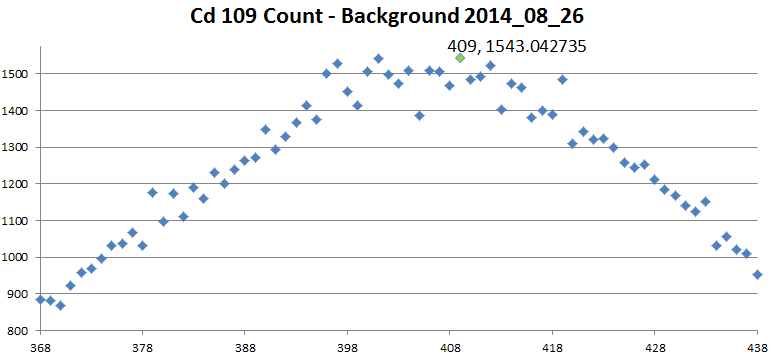Summary: Things are getting more hectic with classes starting back up and a few other projects running around the lab. A new run was taken with the Cd 109 source spaced as in the Dewar, but without the Dewar present. The count rates ramped right back up as expected. It still remains to find out why the Cd 109 source appeared to be more attenuated than the Cs 137 source.
If you're new to the experiment, scroll to the bottom for more background.
|
Bias
|
1500 V
|
|
Gate Window
|
0.5 uS
|
|
Threshold
|
1.5mV
|
|
Attenuation
|
0 dB
|
|
Data set
|
HBC_00022
|
|
Source
|
Cd 109 Dewar spacing, but no Dewar
|
|
Start Time
|
8:29 AM
|
|
Stop Time
|
11:22
|
|
Date
|
2014_08_20 – 2014_08_21
|
|
x-y scope V/div
|
1, 0.5
|
|
Shielded?
|
Yes
|
|
Tube
|
Harshaw B-
|

Without the Dewar present, the count rates went back up on
the Cd 109 source and both peaks were readily apparent.
Background
Hirsch's theory of hole superconductivity proposes a new
BCS-compatible model of Cooper pair formation when superconducting materials
phase transition from their normal to their superconducting state[1]. One
of the experimentally verifiable predictions of his theory is that when a
superconductor rapidly transitions, (quenches), back to its normal state, it
will emit x-rays, (colloquially referred to here as H-rays because it's
Hirsch's theory).
A superconductor can be rapidly transitioned back to its normal state by placing it in a strong magnetic field. My experiment will look for H-rays emitted by both a Pb and a YBCO superconductor when it is quenched by a strong magnetic field.
A superconductor can be rapidly transitioned back to its normal state by placing it in a strong magnetic field. My experiment will look for H-rays emitted by both a Pb and a YBCO superconductor when it is quenched by a strong magnetic field.
This series of articles chronicles both the experimental lab
work and the theory work that’s going into completing the experiment.
The lab book entries in this series detail the preparation and execution of this experiment… mostly. I also have a few theory projects involving special relativity and quantum field theory. Occasionally, they appear in these pages.
The lab book entries in this series detail the preparation and execution of this experiment… mostly. I also have a few theory projects involving special relativity and quantum field theory. Occasionally, they appear in these pages.
Call for Input
If you have any ideas, questions, or comments, they're very
welcome!
References
1. Hirsch, J. E.,
“Pair production and ionizing radiation from superconductors”, http://arxiv.org/abs/cond-mat/0508529


Comments
Post a Comment
Please leave your comments on this topic: